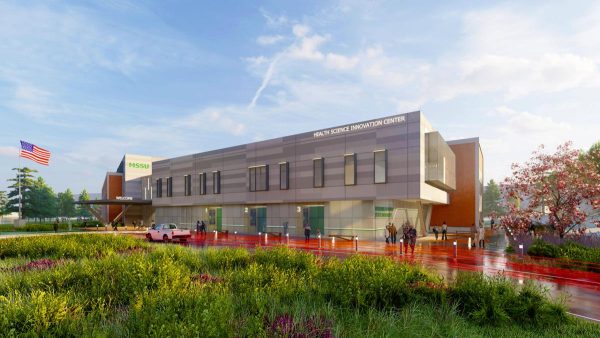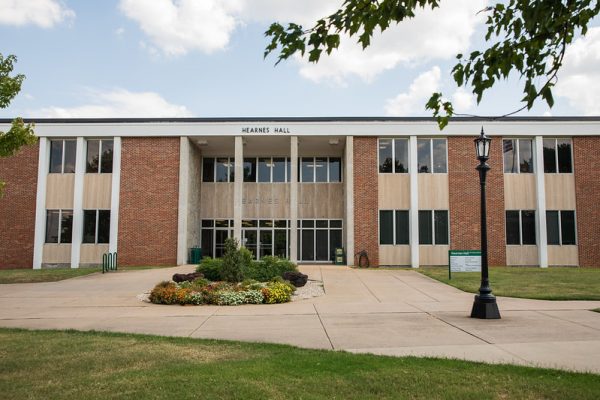2011 tornado affected community identity
Ten years after an E5 tornado took the lives of 161 people and destroyed the town, Joplin’s community has proven its resilience and adaptability regarding education, arts and culture, and the expansion of local businesses.
In fall 2011, freshman and sophomores crowded the halls of the new-to-them Memorial High School campus, ready to start their first year in a make-shift school following the destruction of Joplin High School.
Following the tornado, Joplin School’s administration worked quickly to find and locate students, providing any necessary supplies.
For over a decade, Dr. Kerry Sachetta was the principal of Joplin High School, but now he has stepped up in his career as the assistant superintendent of operations for the Joplin Schools. Sachetta reflects on how Joplin Schools quickly began their problem-solving efforts after the tornado ripped through the town.
“We kind of built our own little supply house and made donations and everything. We took care of anybody that needed help, but we also primarily made sure that our students and their families knew where they could get help. That was the first thing, people,” said Sachetta.
The next issue at hand was developing a way to manage a surplus of people flooding into Joplin to help.
“It was unbelievable when you think about it, I mean hundreds of thousands of people were showing up and asking what they could do. Our first question was what do we let them do? We had to hire people to manage volunteers to help us, which was a good thing, but it was something we never thought about. Who would think that?” said Sachetta.
After volunteers were managed, students were located, and inventory was accounted for, administrators began brainstorming to answer the biggest question they had: where would high schoolers go to school?
“I from the start always wanted to make sure that we had the 11th and 12th graders out at the mall for the simple purpose of that’s where the parking was. At Memorial we don’t have a lot of parking. It would have been a traffic jam nightmare,” said Sachetta.
While problem-solving parking issues, the administration also acquired Memorial Hall as a rental to house orchestra and band students from both campuses and elected to have a 15-minute gap of time between campuses to accommodate teachers and students who needed to travel back and forth throughout the day.
“Learning to use the laptops and learning to teach digitally, utilizing different resources, and not having the resources they had the previous year was very difficult for the teachers,” said Sachetta. “I give them a lot of credit for going through that because that was a big ask and we gave them a lot of support, which we needed to.”
With a transitioning to a new location and from having books one year to using laptops the next, students struggled academically in the first year following the tornado. Eventually the shock subsided, and students embraced a new normal.
“When you go through a lot of trauma like that and your educational world is upset and it’s difficult to get yourself back to where you need to be. At the same time, you’re trying to make a sense of purpose in your community and get back on your feet with your friends and the people you rely on. I think there was a lot of cultural building type activities. We had a lot of volunteers, a lot of money, and a lot of charitableness thrust upon us, like prom for instance,” said Sachetta.
Sachetta recalled another instance of charitableness when he was the principal of Joplin High School. A donation for $100,000 to start a science research program so long as Joplin High School partnered with Kirkwood High School.
“We have kids who take advanced placement statistics now along with this science resource course and kids have received scholarships and national awards because of it. They’re getting ready for college they’re doing graduate type work in high school and it is still going on. It’s one of those things that grew out of the tornado, in a very high academic way,” said Sachetta.
Eventually, academic achievement leveled itself out.
“As I left my last year at Joplin high school, we had our student achievement back up to where we were pre-tornado. I was really pleased with that. In fact, we had the best graduation rate we probably have ever had, even since before the tornado. The teachers worked very hard and the kids were outstanding in terms of their flexibility and their willingness to roll with the changes,” said Sachetta.
Updated safety measures were implemented in Joplin schools, including the use of tornado shelters.
“One thing that changed was not putting kids in the hallways. If we’d have had kids in the hallways in Joplin high school during the tornado, we would have had a lot of kids who would have been casualties, and staff members, and that would have been horrific,” said Sachetta.
While improvements and opportunities were made after the tornado came through Joplin, Sachetta takes nothing for granted.
“I won’t say that the tornado had a silver lining,” said Sachetta. “So many still suffer trauma because they set through it and won’t be able to forget because it was a horrible experience. But hopefully over time, things will get better for those folks and have gotten better over the last ten years, and we always have fond memories of the loved ones we’ve lost, but as we build back.”
Arts and Culture
Another aspect of Joplin’s community identity is its abundance of art and culture. Third Thursday started in 2008 with the help of Linda Peter, who also created the Joplin arts district, owns Urban Art Gallery, and co-founded the Joplin Regional Artist Coalition in 2010.
“We had a big meeting at the art walk after the tornado and we paid tribute to the deceased,” said Peter. “We had the window with hearts with the people’s names on them at church across the windows.”
Peter recalls the first art walk following the tornado.
“We wanted to carry on and a huge amount of people came: the volunteers who were in town, corporate people, insurance people, and the community themselves because they all came down for the entertainment value of it. In fact, for some it was the first time they were seeing their neighbors. They didn’t know who had made it out safely,” said Peter.
With a large portion of the community coping with the aftermath of the tornado, many people welcomed the distraction the art walk provided.
“We were thanked for doing this. For doing something normal at that time when they were not in a normal situation personally, but they thanked us for the healing aspect of the art walk and programs thereafter,” said Peter.
Joplin Regional Arts Coalition was created shortly before the tornado hit Joplin and between 35 to 50 members were negatively impacted by the storm.
“Many of them lost their homes or their studios or all of their art, so we were trying to help them and help them find grants because there are some grant programs that were available for about maybe $500 to $1000 that could help them. And getting supplies donated,” said Peter.
Getting the community involved in art was important to Peter and other local artists.
“We were getting programs for children during art walk so they could paint a butterfly or do something, and of course the community mural was already planned for 15th street and it changed into a community mural after the tornado,” said Peter. “There was a lot of changes, but a lot of the things we knew were not changed because of the location where most of the arts and cultural events were taking place.”
Ingraining art into Joplin’s sense of community was a work in progress before the tornado.
“Art walk started in 2008, and that was kind of the beginning of the whole nature. Spiva Center was having Art on Tap at that time. I don’t feel that the tornado changed anything aside from the topics of our art might have changed. We made a lot more butterflies than we ever planned after the tornado,” said Peter.
While the tornado may have created setbacks and destroyed the work of several local artists, the art community of Joplin stood strong in the face of adversary and rebuilt.
“I think what the tornado did for Joplin was that it brought the community together, so of course, in our case, it brought the community of the arts and artists together because we had a common loss, a common passion, and a common feeling that we needed to help people and a sense of grief that we wanted to share the healing of the arts,” said Peter.
Local Businesses
“Through our Chamber Foundation it allows our organization to quickly responds when a crisis occurs,” said Erin Slifka, the marketing and public information manager for Joplin Area Chamber of Commerce. “After Joplin was devastated by the tornado in 2011, the foundation simplified the process of accepting donations for disaster recovery.”
553 Joplin businesses were destroyed or severely damaged by the tornado. Of those businesses, 500 reopened and 30 indicated they had no plans to reopen.
The U.S. Small Business Administration approved more than $43.4 million in low-interest disaster loans for individuals, businesses, and non-profit organizations who were impacted by the tornado. 100 low-interest disaster loans were given to Joplin businesses for $ 16.4 million.
According to the Joplin Area Chamber of Commerce in Feb. 2016, more than 300 new businesses opened in Joplin following the 2011 tornado, providing new jobs for about 960 full-time employees and roughly 717 part-time employees.
“The Advanced Training and Technology Center (ATTC), which is owned and operated by the Joplin Area Chamber of Commerce foundation, was developed as part of the City of Joplin’s capital planning process. ATTC opened in 2017 to fulfill a need in our community with education, business assistance, and job creation. $5.5 million of CDBG-DR funds were used for the property and program services,” said Slifka.
The ATTC encourages members of the community to develop job-skills which would benefit them throughout their careers.
“The facility is now at 100% occupancy, supporting several new businesses that are hiring. The ATTC is also host to Crowder College’s training facility for welding, information technology, warehouse logistics, and other career training,” said Slifka.
There are several events taking place within the ACCT with the sole purpose of encouraging people to develop their careers in Joplin to generate income flow into the community.
“The center also hosts many events in its commons such as Tomorrow’s Leaders Today, Leadership Joplin, and the new Joplin chapter of 1 Million Cups, a Kauffman Foundation initiative. It’s a great addition to downtown Joplin’s entrepreneurial ecosystem, serving new startups, and launching the careers of many individuals,” said Slifka.
Your donation will support the student journalists of Missouri Southern State University. Your contribution will allow us to purchase equipment and cover our annual website hosting costs.





























